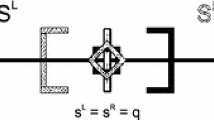Abstract
It is known that if exogenous cost heterogeneities between the firms in a spatial duopoly model are large, then the model does not have a pure-strategy equilibrium in location choices. It is also known that when these heterogeneities are stochastically determined after firms choose their locations, spatial agglomeration can appear. To tackle these issues, the current paper modifies the spatial framework by allowing firms to exchange the cost-efficient production technology via royalties. It is shown that technology transfer guarantees the existence of a location equilibrium in pure strategies and that maximum differentiation appears in the market.
Similar content being viewed by others
References
Anderson SP, Neven DJ (1991) Cournot competition yields spatial agglomeration. Int Econ Rev 32: 793–809
Beggs AW (1992) The licensing of patents under asymmetric information. Int J Ind Organ 10: 171–191
Choi JP (2001) Technology transfer with moral hazard. Int J Ind Organ 19: 249–266
Christou C, Vettas N (2005) Location choices under quality uncertainty. Math Social Sci 50: 268–278
D’ Aspremont C, Gabszewicz J, Thisse JF (1979) On Hotelling’s “Stability in Competition”. Econometrica 47: 1145–1150
Faulí-Oller R, Sandonís J (2002) Welfare reducing licensing. Games Econ Behav 41: 192–205
Filippini L (2005) Licensing contract in a Stackelberg model. Manchester School 73: 582–598
Gallini NT, Wright BD (1990) Technology transfer under asymmetric information. RAND J Econ 21: 147–160
Hamilton JH, Thisse JF, Weskamp A (1989) Spatial discrimination: Bertrand vs. Cournot in a model of location choice. Reg Sci Urban Econ 19: 87–102
Kabiraj T (2004) Patent licensing in a leadership structure. Manchester School 72: 188–205
Kamien MI, Tauman Y (1984) The private value of a patent: a game theoretic analysis, Z. Nationalökon. 4(Suppl): 93–118
Kamien MI, Tauman Y (1986) Fees versus royalties and the private value of a patent. Q J Econ 101: 471–491
Kamien MI, Tauman Y (2002) Patent licensing: the inside story. Manchester School 70: 7–15
Katz ML, Shapiro C (1985) On the licensing of innovations. RAND J Econ 16: 504–520
Katz ML, Shapiro C (1986) How to license intangible property. Q J Econ 101: 567–589
Macho-Stadler I, Pérez-Castrillo JD (1991) Contrats de licence et asymétrie d’ information. Ann Econ Statist 24: 189–208
Marjit S (1990) On a non-cooperative theory of technology transfer. Econ Lett 33: 293–298
Matsumura T, Matsushima N (2009) Cost differentials and mixed strategy equilibria in a Hotelling model. Ann Reg Sci 43: 215–234
Mayer T (2000) Spatial Cournot competition and heterogeneous production costs across locations. Reg Sci Urban Econ 30: 325–352
Mukherjee A (2001) Technology transfer with commitment. Econ Theory 17: 345–369
Muto S (1993) On licensing policies in Bertrand competition. Games Econ Behav 5: 257–267
Saracho AI (2002) Patent licensing under strategic delegation. J Econ Manage Strategy 11: 225–251
Sen D, Tauman Y (2007) General licensing schemes for a cost-reducing innovation. Games Econ Behav 59: 163–186
Sen D (2005) Fee versus royalty re-considered. Games Econ Behav 53: 141–147
Shapiro C (1985) Patent licensing and R&D rivalry. Am Econ Rev Pap Proc 75: 25–30
Wang XH (1998) Fee versus royalty licensing in a Cournot duopoly model. Econ Lett 60: 55–62
Ziss S (1993) Entry deterrence, cost advantage and horizontal product differentiation. Reg Sci Urban Econ 23: 523–543
Author information
Authors and Affiliations
Corresponding author
Rights and permissions
About this article
Cite this article
Matsumura, T., Matsushima, N. & Stamatopoulos, G. Location equilibrium with asymmetric firms: the role of licensing. J Econ 99, 267–276 (2010). https://doi.org/10.1007/s00712-009-0104-9
Received:
Accepted:
Published:
Issue Date:
DOI: https://doi.org/10.1007/s00712-009-0104-9



